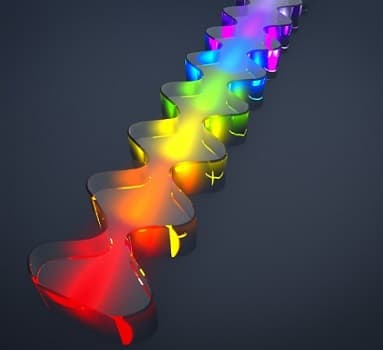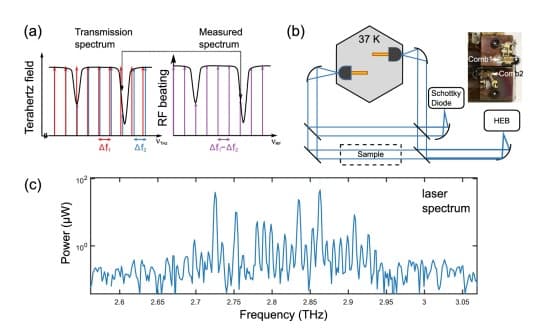Researchers At MIT Discover New Spectroscopic Method To Detect Explosives
Researchers in MIT’s Research Laboratory of Electronics discovered a new spectroscopic method to detect materials based on their spectroscopic ‘fingerprints’. The technology can be applied in identifying different kinds of materials, including chemicals used in drugs and explosives.

Qing Hu-One of the researchers of the team
Just like humans have different fingerprints, different materials have different spectroscopic signatures. It means that different materials react differently to the incident electromagnetic wave of a particular wavelength and frequency. A method named as ‘Terahertz Spectroscopy’ exists which uses the spectrum band between microwaves and infrared light of the electromagnetic radiation which is used to extract the spectroscopic ‘fingerprints’ of different materials.
However, the existing method came to be time consuming and impractical. The time consumed in just scanning a single sample varies from 15-30 minutes and requires a radiation source which is heavy in nature. Applying this setup can cause fatal harm to its user if prior protection isn’t taken, and can even contaminate the sample with radiation.
They have modified the existing method and thus came up with a new system which has a size of a computer chip. The new ‘Terahertz spectroscopy’ system uses Quantum Cascade Laser (QCL) and can generate spectroscopic signature of a sample in just 100 microseconds. The QCL laser emits radiation in a form of ‘frequency comb’ which consists of electromagnetic radiation of different frequencies and thus generates the response of a material in short duration of time.

An artist's impression of a frequency comb emitted from QCL
QCL lasers just like any other electronic lasers does optical pumping of the electromagnetic radiations until it has enough energy to escape the system. Frequency comb consists of electromagnetic waves of evenly spaced frequencies. However, the existing laser can’t produce so. Thus, the system has been modified by the researchers in order to produce an evenly spaced frequency combs. The detailed work of their research has been published in the Journal named Optica, Optical Society of America (OSA).
In order to verify their work, they first analyzed the signature of an optical device named etalon, which is made from wafers of gallium arsenide. The spectral properties of gallium arsenide can be calculated theoretically in advance and thus can be matched with the result of the newly developed system. The results made quite a good fit and thus indicated that other chemical materials can also be detected using this technology.

Outcomes from the experiment- Terahertz profile and field plot
However, ‘Terahertz Spectroscopy’ chip based system requires extremely low temperature to work efficiently and thus needs a cool housing which is quite bulky in nature. They are now trying to reduce the power consumption so that the method can be practiced under normal temperatures. They have achieved this as they have mentioned in their study that they can identify a material by just using 10 watts power consumption and 1 percent of the radiation burst.
Modifying the existing method allows the system to be applied in different security and defense related systems. They can be used to make revolutionary advancements in the field of spectroscopy. Further, it can also be installed in places of inspection to identify illegal transport of prohibited drugs, materials and also explosives.
Source- <a href="https://news.mit.edu/2016/speedy-terahertz-based-system-could-detect-explosives-0520" target="_blank" rel="nofollow noopener noreferrer">Speedy terahertz-based system could detect explosives | MIT News | Massachusetts Institute of Technology</a>

Qing Hu-One of the researchers of the team
However, the existing method came to be time consuming and impractical. The time consumed in just scanning a single sample varies from 15-30 minutes and requires a radiation source which is heavy in nature. Applying this setup can cause fatal harm to its user if prior protection isn’t taken, and can even contaminate the sample with radiation.
They have modified the existing method and thus came up with a new system which has a size of a computer chip. The new ‘Terahertz spectroscopy’ system uses Quantum Cascade Laser (QCL) and can generate spectroscopic signature of a sample in just 100 microseconds. The QCL laser emits radiation in a form of ‘frequency comb’ which consists of electromagnetic radiation of different frequencies and thus generates the response of a material in short duration of time.

An artist's impression of a frequency comb emitted from QCL
QCL lasers just like any other electronic lasers does optical pumping of the electromagnetic radiations until it has enough energy to escape the system. Frequency comb consists of electromagnetic waves of evenly spaced frequencies. However, the existing laser can’t produce so. Thus, the system has been modified by the researchers in order to produce an evenly spaced frequency combs. The detailed work of their research has been published in the Journal named Optica, Optical Society of America (OSA).
In order to verify their work, they first analyzed the signature of an optical device named etalon, which is made from wafers of gallium arsenide. The spectral properties of gallium arsenide can be calculated theoretically in advance and thus can be matched with the result of the newly developed system. The results made quite a good fit and thus indicated that other chemical materials can also be detected using this technology.

Outcomes from the experiment- Terahertz profile and field plot
However, ‘Terahertz Spectroscopy’ chip based system requires extremely low temperature to work efficiently and thus needs a cool housing which is quite bulky in nature. They are now trying to reduce the power consumption so that the method can be practiced under normal temperatures. They have achieved this as they have mentioned in their study that they can identify a material by just using 10 watts power consumption and 1 percent of the radiation burst.
Modifying the existing method allows the system to be applied in different security and defense related systems. They can be used to make revolutionary advancements in the field of spectroscopy. Further, it can also be installed in places of inspection to identify illegal transport of prohibited drugs, materials and also explosives.
Source- <a href="https://news.mit.edu/2016/speedy-terahertz-based-system-could-detect-explosives-0520" target="_blank" rel="nofollow noopener noreferrer">Speedy terahertz-based system could detect explosives | MIT News | Massachusetts Institute of Technology</a>
0

